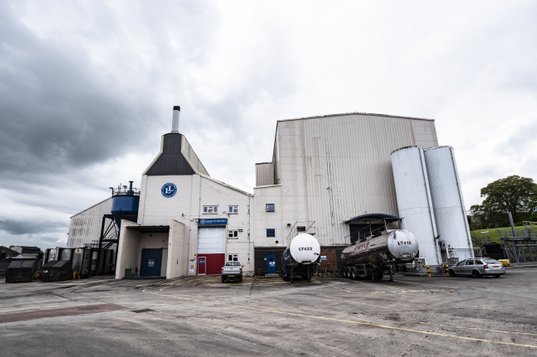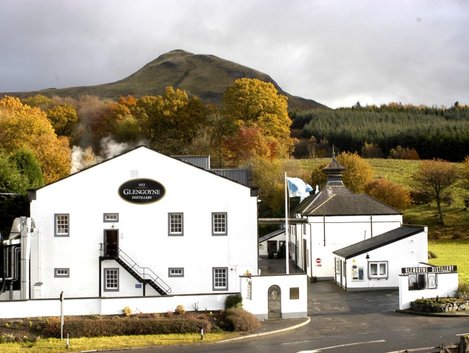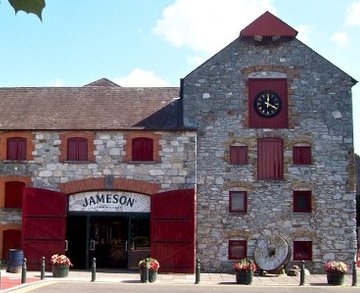The Major A. A. Gordon Whisk(e)y Pals
Distilleries with a connection to Major Gordon
THE STIRLING DISTILLERY - Closest distillery of Major Gordon's hometown
Whisky hadn't been produced in Stirling before Major Gordon was born. The last known legal distillery was closed in 1852. The new distillery opened in the historic building locally known as The Old Smiddy, located in the shadow of Stirling Castle. Legend has it that King James VI stabled his horses here in the 1500s. The current building was erected in 1888 as a local church temperance hall.
The new distillery was opened in 2019, the same year the Major A. A. Gordon Society was established, with its main focus on gin, for which it has won numerous awards as
a visitor attraction and for its range of gins. It intends to move slowly into whisky as the business grows. The first releases of Stirling whisky are anticipated to be ready in late 2026 and will be followed by their VI Casks for King James limited edition six-bottle set. However, Stirling Distillery expanded into whisky with the launch of their Sons of Scotland independent bottling range in 2020. The collection celebrates the history of Stirlingshire's rich whisky-making heritage. It is a series of single-cast bottlings, each named after historical Stirlingshire distilleries like the Cambusbarron, the Stoneywood, The Arngibbon, The Cashly and the Blended Malt Castle Rock.
They were all aged in a 7-year-old red wine cask - almost ruby red - from an island in the north of Scotland.
FALKIRK DISTILLERY
Falkirk Distillery is located only 19 miles from Major Gordon's hometown, Bridge of Allan. It's the first distillery to be built from the ground up, in the region for over 30 years, sourcing two copper stills and a mash tun from the now-closed Speyside distillery, Caperdonich The Lowland Whisky distillery released its inaugural whisky in 2023. The stunningly golden unpeated malt whisky has come from a marriage of two first-fill bourbon casks from Heaven Hill in Kentucky and aged for three years and one day from September 2 2020.
Falkirk Whisky is an initiative of the Stewart family, who established the Falkirk Distillery on the UNESCO World Heritage. George Stewart leads this family-owned and independent distillery. A primary source for the whisky is the 240-foot deep wellspring of the purest Scottish water. The building of the distillery and its warehouses in its traditional style and onion-shaped copper stills reflect the core values of whisky production.
THE LOCH LOMOND DISTILLERY
In 1814 the first Loch Lomond Distillery was established in the area of Tarbet (known
as Tarbat). There is not much known of the old distillery of yore which only closed three years later.
In 1964 a new Loch Lomond distillery was founded by the current owners of the Littlemil Distillery. This time the distillery was located at Bowling (just a few miles from Glasgow). The first bottles came on the market the year after.
THE GLENGOYNE DISTILLERY AT DUMGOYNE
The Glengoyne distillery is situated 26 miles from Major Gordon's hometown, Bridge of Allan, and only 20 miles north outside of Glasgow. The distillery is located on the Highland line
where the whisky is made in the Highlands, making it a Highland Scotch Whisky but aged in the Lowlands.
On almost every bottle of Glengoyne Whisky, the date 1833 is present. During its first years of production, the distillery produced whisky illegally, making it an Illicit distillery. It was first known as the Burnfoot Distillery. When the distillery was sold 1876 to the Lang Brothers, it was supposed to be named Glengoyne, but the clerk registered it as Glen Guin (Glen of the Wild Geese). The distillery finally received its proper name at the turn of the century. In 1965, the Robertson & Baxter group took over the distillery, which is now the Edrington Group. In 1984, Glengoyne received the Royal Warrant. The water that is used comes from the river Glengoyne Burn, which debouches into the lake of Loch Lomond. Glegoyne is regularly referred to as the “most beautiful distillery in Scotland”. The distillery is one of only three distilleries remaining today that use Golden Promise barley, which is low in yield but high in quality. Glengoyne and Maccallen are the only two Scots distilleries of these three.
THE GLENTURRET DISTILLERY - Founder James Fairlie owned Major Gordon's home 'Jessamine' in Bridge of Allan.
Located near Crieff in Perthshire on the banks of the Turret River the distillery was originally known as "Hosh" and owned by the Drummond family. In 1845, it was taken over by John McCallum, who, in his turn, sold it to Thomas Stewart, who renamed it Glenturret. During the outbreak of the First World War, the distillery closed and reopened afterwards under the Mitchell Brothers. The American prohibition and depression led to the closure in 1921, and it was only reopened in 1957 when it was revitalised by James Fairlie. Fairlie created a whisky in the traditional fashion to preserve the craft of distilling. In 1981 the distillery was bought by Cointreau and was passed down to Highland Distillers in 1990. Nine years later it was bought by The Edrington Group and is currently run by the Lalique Group since 2018.
THE IRISH JAMESON AND BUSHMILLS DISTILLERIES
Both Irish distilleries are connected with Major Gordon through the Irish roots of his family in the town of Strabane in Ireland, as well as Major Gordon's wife's roots in Cork, the place where
the Jameson distillery stands.








